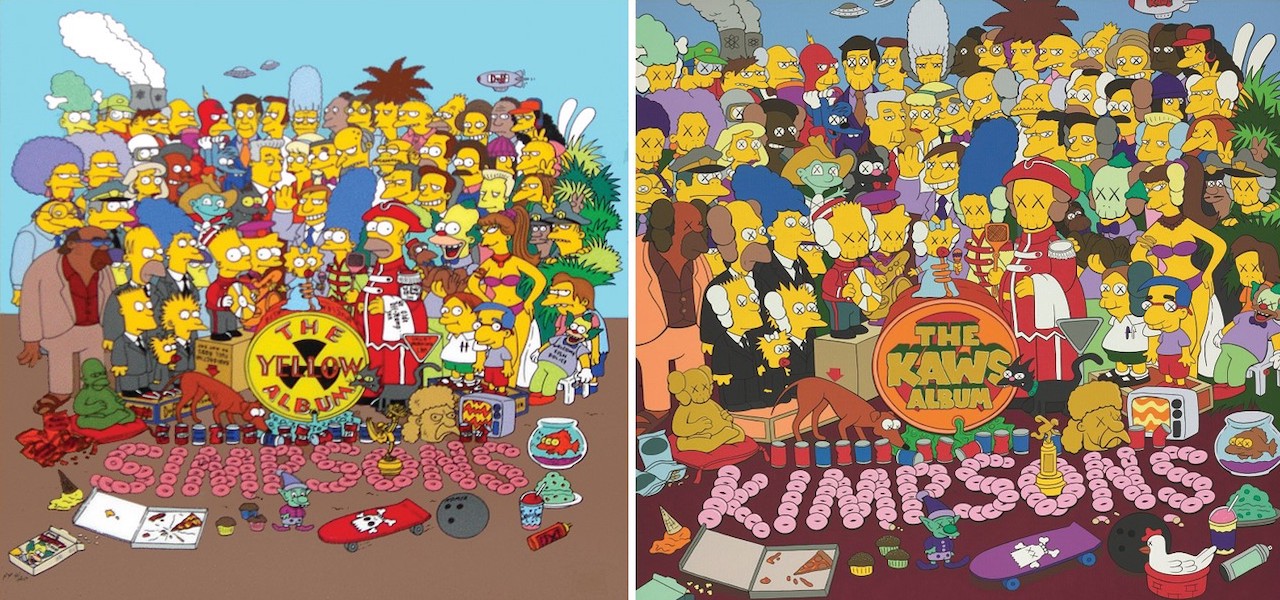

A Tracing Of Bill Morrison’s Artwork Sold For $15 Million — He Received No Credit Or Compensation
In April, we reported that a painting by Kaws (real name Brian Donnelly) had sold at auction for $14.8 million — a career high for the American artist, and a far bigger sum than estimated. Like many of his works, “The KAWS Album” replicates icons of pop culture, replacing their eyes with “X” crosses. In this case, the model is the cover of The Simpsons’ The Yellow Album, a 1998 collection of original songs sung by the characters.
At the time, the record-breaking sale — and indeed the existence of “The KAWS Album” — escaped the notice of Bill Morrison, the artist behind the original Simpsons cover. When he was told about the auction recently, Morrison went through a range of emotions. In his view, Kaws had effectively ripped him off. “Because of the amazingly high purchase price, I felt an instant kinship with other comic book artists who have had their work stolen and turned into ‘fine art,'” Morrison tells Cartoon Brew.
To complicate matters, Morrison’s cover is itself derivative of a famous piece of pop art: the cover of The Beatles’s 1967 album Sgt. Pepper’s Lonely Hearts Club Band. But, in his view, his work is legitimate parody. He describes to Cartoon Brew the differences between his and Kaws’s approaches:
For something to be a successful parody, you want the audience to recognize the source. In the case of my Yellow Album piece, that was easy. The Beatles album cover is so iconic that my Simpsons version was instantly recognized by the world as a parody. Also, my art was hand-drawn, inspired by the original Beatles cover, but not traced off from it, making it an authentically original piece of art (though inspired by someone else’s work, in this case that of Jann Haworth and Peter Blake.)
The Kaws painting has been mistaken for a parody of the original Beatles album cover, with no mention of the actual source, my artwork. I believe that Kaws’ audience largely has no knowledge of the Simpsons Yellow Album, and if that’s the case his painting would not be a parody. Of course, it’s possible that Kaws has misjudged his audience and thinks my piece is more famous than it is.

Morrison has cause to argue that his work hasn’t been adequately acknowledged. After “The KAWS Album” sold at auction, some media — including The New York Times — failed to identify the painting’s obvious resemblance to Morrison’s design, comparing it directly to the Sgt. Pepper’s cover. The fact that his contribution has been erased is what frustrates Morrison; otherwise, he recognizes that Kaws’s work has precedent in the history of art:
I think the Kaws painting of my Simpsons Yellow Album art represents a modern trend in fine art that has its roots in Dadaism. Find a mundane object or piece of art, change it a bit, and call it art (or call it your own art.) The Kaws painting isn’t much different from DuChamp’s “L.H.O.O.Q.” where he painted a mustache on the “Mona Lisa” and retitled it. Or, you could compare it to Pop Art painting such as those of Roy Lichtenstein or Mel Ramos who copied comic book images from artists such as Russ Heath, John Romita, and Carmine Infantino with very few changes made.
Russ Heath was a friend of mine, so I know from personal conversations that he was injured by the fact that his images sold for millions of dollars, without a penny going to him. Russ passed away last year. He was on a fixed income, living on social security and an occasional commission. Russ did a comic strip about his experience with the Lichtenstein paintings [read it on Comics Alliance], and I know it bothered him that people were making so much money from his work while he struggled to get by.
So the news of the Kaws painting struck a chord with me. If nothing else, I hope this creates awareness of the fact that comic book artists, who generally work insane hours and don’t make a lot of money, have to see their images appropriated by the fine art world to this day, without any additional compensation, and that’s just not right.
Kaws meanwhile is reaping the windfall of his Simpsons auction. Earlier this month, he paid $17 million for a 10,000-square-foot building in the Williamsburg neighborhood of Brooklyn. The building is intended ot be an expansion of his existing studio, which is located next door.
If Kaws is sued, it won’t be by Morrison, who notes that the copyright for his cover is held by Disney/Fox. In any case, the controversy may evoke memories for Kaws, who started out by making illegal street art. Although he told The New York Times that he hasn’t painted illegally since “about 2001,” Kaws continues to create X-eyed versions of famous characters, reinterpreting everyone from Mickey Mouse to the Smurfs. His work has earned him 2.6 million Instagram followers, two studios in New York, and a forthcoming show at the Brooklyn Museum. (Cartoon Brew reached out to Kaws for comment, but he has not responded at time of publication.)

Yet as he courts mass appeal, Kaws also draws controversy. Morrison isn’t the first to question his credentials as a “fine artist” — many dismiss his work as shallow or formulaic. Even Anne Pasternak, the director of the Brooklyn Museum, admitted that she “didn’t see the appeal initially” and recognizes that he “makes the art world uncomfortable.”
Morrison is an illustrator and writer who is closely associated with Matt Groening’s projects, including The Simpsons. He drew the very first Simpsons spin-off comic, and worked as an art director on Futurama, and an artist and designer on Disenchantment. He also illustrated a graphic-novel adaptation of The Beatles’s seminal animated feature Yellow Submarine.
(Image at top: a comparison of Morrison’s work [left] and Kaws’s [right].)

.png)